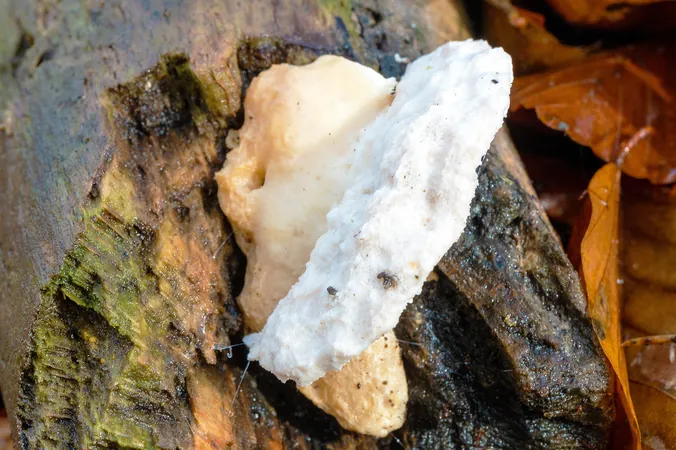
Scientists Discover the Most Bitter Substance on Earth: Prepare to Pucker Up!
2025-04-15
Author: Ying
Bitterness. It's that flavor that makes us cringe, often associated with overcooked veggies or that one bad fruit. But what if I told you that scientists have recently dug deeper into this mysterious taste, uncovering a fascinating substance that takes ‘bitter’ to a whole new level?
The Quest for Bitter Insights: Meet Amaropostia Stiptica
In an intriguing study, experts from the Leibniz Institute for Food Systems Biology at the Technical University of Munich and the Leibniz Institute of Plant Biochemistry embarked on a journey to explore the bitter properties of a little-known forest mushroom named Amaropostia stiptica, or the bitter bracket mushroom.
This unique fungus thrives on dead trees, sporting a shelf-like fruiting body that looms over rotting wood. While it’s harmless, its taste is notorious for pushing even the most adventurous eaters away!
What Makes Amaropostia Stiptica So Special?
Found primarily in tropical and subtropical forests, this crust-like fungus isn’t flashy. It’s often spotted forming thin, resiny layers on decayed hardwood, flaunting a smooth, pale surface that ranges from creamy beige to soft yellow. Yet, beneath its understated appearance lies a vital role in the ecosystem—it helps decompose tough plant materials, returning nutrients to the forest floor.
What We Know About Bitter Compounds (And What We Don’t!)
Our understanding of bitter compounds has mainly come from flowering plants and synthetic sources. There’s even a database called BitterDB, which highlights over 2,400 known bitter molecules! However, only a small portion have been linked to a known human taste receptor.
The intriguing part? Many sources of bitterness remain a mystery—especially those from animals, bacteria, and fungi, making mushrooms like Amaropostia prime candidates for new discoveries.
Not All Bitter is Bad: The Complex Reality!
While our bodies utilize bitter taste receptors, called TAS2Rs, as a protective mechanism against potential toxins, not all bitter compounds signal danger. For example, the infamous death cap mushroom is perilous but offers no bitter taste. This complexity raises scientific eyebrows—why do we have these receptors in other parts of our bodies, from the stomach to the lungs?
Newly Discovered Bitter Compounds: A Game Changer?
With the goal of expanding knowledge on bitterness, the research team utilized cutting-edge techniques to uncover three new bitter compounds from Amaropostia stiptica. All three were found to activate human taste receptors, but one compound, oligoporin D, stood out. Astoundingly, this molecule triggered the TAS2R46 receptor at an ultra-low concentration—about 63 micrograms per liter! For context, that’s akin to dissolving just a tiny pinch of it in over 100 bathtubs of water.
Bitterness: A New Frontier for Health?
These groundbreaking findings could revolutionize our approach to food and health. As researchers delve further into the molecular diversity of these compounds, the implications could range from creating tastier, healthier foods to better understanding how we process various tastes.
The recent discoveries remind us that bitterness is not merely a taste sensation—it's a complex signal that may guide us toward healthier choices. With every new addition to the bitter compound database, we edge closer to unraveling the enigmatic ways taste influences our health.
This captivating study was published in the Journal of Agricultural and Food Chemistry, sparking fresh interest in the world of bitterness!

 Brasil (PT)
Brasil (PT)
 Canada (EN)
Canada (EN)
 Chile (ES)
Chile (ES)
 Česko (CS)
Česko (CS)
 대한민국 (KO)
대한민국 (KO)
 España (ES)
España (ES)
 France (FR)
France (FR)
 Hong Kong (EN)
Hong Kong (EN)
 Italia (IT)
Italia (IT)
 日本 (JA)
日本 (JA)
 Magyarország (HU)
Magyarország (HU)
 Norge (NO)
Norge (NO)
 Polska (PL)
Polska (PL)
 Schweiz (DE)
Schweiz (DE)
 Singapore (EN)
Singapore (EN)
 Sverige (SV)
Sverige (SV)
 Suomi (FI)
Suomi (FI)
 Türkiye (TR)
Türkiye (TR)
 الإمارات العربية المتحدة (AR)
الإمارات العربية المتحدة (AR)